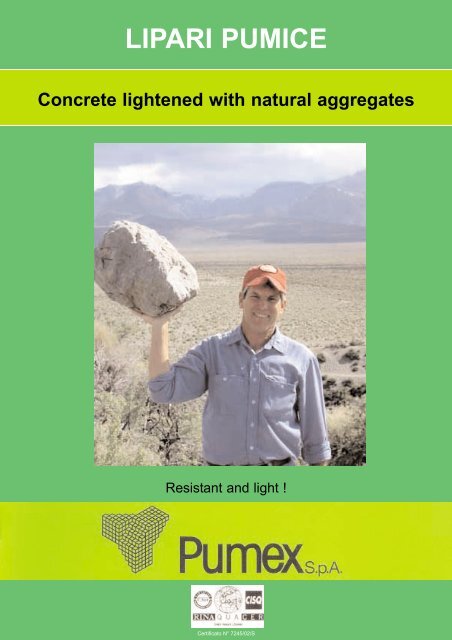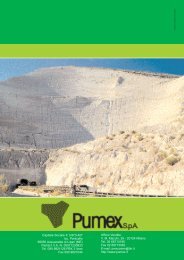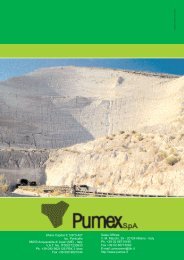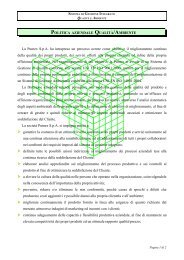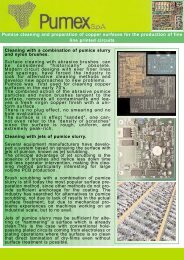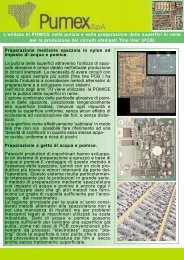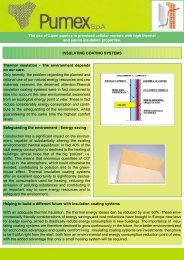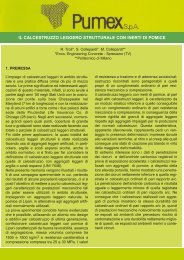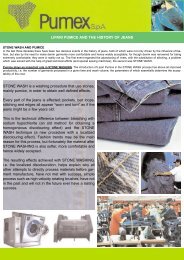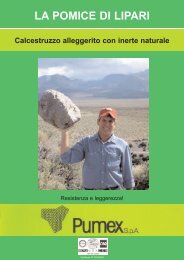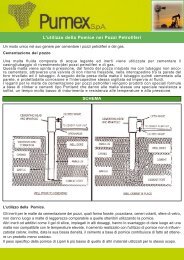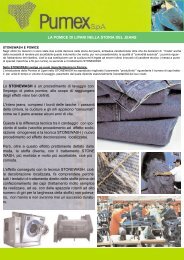LIPARI PUMICE
LIPARI PUMICE
LIPARI PUMICE
Create successful ePaper yourself
Turn your PDF publications into a flip-book with our unique Google optimized e-Paper software.
<strong>LIPARI</strong> <strong>PUMICE</strong><br />
Concrete lightened with natural aggregates<br />
Resistant and light !<br />
Certificato N° 7245/02/S
Interest regarding lightweight structural concrete is consistently increasing, especially since it is particularly advantageous in prefabs,<br />
where the possibility of using light structural elements help to solve many problems. The use of lightweight structural concrete<br />
is justified, if the following two fundamental requirements are met:<br />
1) An appropriate resistance is obtained (>= 15 N/mm²)<br />
2) The possibility to reinforce the prefab's elements exists, and that the reinforced and pre-stressed beams tend to experience<br />
problems such as shrinkage, freeze resistance, and deformation.<br />
The possibility to reinforce lightweight concrete requires that there is sufficient adherence with the steel framework to ensure the<br />
transmission of tensile stress, from the steel bars to the concrete without slippage or diminishing the protection against corrosion.<br />
The best results in the research for a lightweight concrete with Lipari pumice aggregate, where the resistance values enter with<br />
the limits required of structural concrete, has been obtained with an opportune dosage of pumice aggregate not containing fine<br />
pumice particles, but substituted with crushed rock fine particles, and the opportune use of additives to better the mechanical<br />
characteristics, the adherence to steel and to limit the amount of shrinkage.<br />
Optimum mix tests<br />
Mix composition kg/m³<br />
E - 350* E a - 350 ** R - 250***<br />
Portland Cement 425 350 350 250<br />
Effective Water 175 135 165<br />
Absorbed Water 64 64<br />
Pumice grain size above 7 mm 260 268<br />
Pumice grain size 3-7 mm 205 212<br />
Sea sand° 129 133<br />
Mountain sand°° 486 502<br />
Gravel 5/15 1.300<br />
Sand 0/2 660<br />
Tiamac Additive 11 (1) 3,40<br />
Stabilmac Additive (2) 35<br />
Total 1.670 1.702,40 2.375<br />
Apparent Density Kg/m3 1.600 1.650 2.350<br />
Compression Resistance<br />
in N/mm2 (kg/cm2 ) 18,64 (190) 22,07 (225) 26,48 (270)<br />
Traction Resistance<br />
in N/mm2 ( Kg/cm2 )<br />
LIGHTWEIGHT STRUCTURAL CONCRETE WITH <strong>LIPARI</strong> <strong>PUMICE</strong> AGGREGATE<br />
*E-350: Basic Mix<br />
**Ea: Basic mix combined with superfluid additive and an expansion agent²<br />
***R-250: Ordinary reference concrete UNI 10020-7<br />
° Natural sand originating from detached quarries in sandy hills found close to<br />
marine coastline<br />
°° Crushed rock fine particles<br />
1,80 (18,30) 2,28 (23,20) 2,28 (23,20)
SHRINKAGE TESTS<br />
-Shrinkage exerience - 2 to 270 days, with 4 test samples 10x10x50cm<br />
-Seasoning UNI 627<br />
-Monitoring with AMSLER UNI 6555<br />
Shrinkage<br />
Values<br />
ADHERENCE TESTS Prove di aderenza :<br />
Conditioning factors:<br />
- Adhesion due to cement's adhesive properties<br />
- Friction due to the locking action of the concrete<br />
- Concrete resistance to the cutting forces caused by the irregularity of the steel contact.<br />
- Surface shape of the framework<br />
- Concrete's resistance characteristics<br />
- Concrete's compactions around the rods<br />
- Aggregate resistance under concentrated loads<br />
- Concrete elasticity<br />
Test Methodology :<br />
"Beam Test" UNI CNR 120-71<br />
"Claw" type steel with high elasticity and an improved adherence<br />
Rods with nominal diameters 12mm and 20 mm (2 tests each)<br />
Apparatus used: hydraulic oil epuipment type Mohr-Federhaff<br />
Loads applied with a tolerance of 10kg.<br />
TENSION CHARACTERISTICS TO ADHERENCE IN N / mm² (Kg / cm²)<br />
Mix<br />
E - 350<br />
E a - 350<br />
R - 250<br />
Regulations require that: Tm>T*m=80-1,2 d<br />
Result of the rods used : :<br />
diam.<br />
mm. 12<br />
mm. 20<br />
The values noted satisfy the conditions outlined in the regulation and one can consider the behaviour of the lightweight pumice concrete adherence<br />
to steel as being good.<br />
This result improves when using rods with an inferior diameter, since the concentrated forces decreas the possibility of breaking the aggregate.<br />
The influence of the additives is positive, and hence the adherence tension result values improve.<br />
CONCLUSIONS<br />
The tests carried our show satisfactory behaviour of Lipari pumice concrete as far as shrinkage and adherence is concerned, making it possible<br />
to use it as lightweight structural concrete, within the tests resistance monitored limits.<br />
(taken from "The shrinkage and adherence problems of lightweight concrete produced using pumice aggregate" Prof. Ing. Pasquale Mancuso e<br />
Prof. Ing. Vincenzo Ruisi dell' Ist. di Scienza delle Costruzioni - Facoltà di Ingegneria - Univ. Palermo - Dr. Ing. Nunzio Miraglia.)<br />
OTHER CONSIDERATIONS<br />
E - 350 *<br />
0,40 mm. for 270 days<br />
shifting ><br />
rod diam. mm<br />
mm. 12<br />
mm. 20<br />
mm. 12<br />
mm. 20<br />
mm. 12<br />
mm. 20<br />
65, 6 Kgf/cm 2<br />
T* m<br />
56 Kgf/cm 2<br />
^<br />
E a - 350 **<br />
0,15 mm. for 270 days<br />
R - 250 ***<br />
0,10 for 270 days<br />
0,01 mm 0,1 mm 1,00 mm<br />
Fa Td Fa Td Fa Td 181,48 4,51 305,48 7,65 429,19 10,69<br />
(1850) (46) (3114) (78) (4375) (109)<br />
139,30 3,43 234,26 5,89 290,67 7,26<br />
(1420) (35) (2388) (60) (2963) (74)<br />
226,61 5,69 463,13 11,57 504,92 12,65<br />
(2310) (58) (4721) (118) (5147) (129)<br />
195,71 4,90 313,13 7,65 350,51 8,73<br />
(1995) (50) (3192) (80) (3573) (89)<br />
167,45 4,22 345,70 8,63 443,41 11,08<br />
(1707) (43) (3524) (88) (4520) (113)<br />
205,52 5,10 286,65 7,16 341,29 8,53<br />
(2095) (52) (2922) (73) (3479) (87)<br />
In conclusion, the test results have shown that lightweight pumice concrete have behavioural characteristics that are very similar to artificial aggregates with a comparable resistance.<br />
Hence, where high resistance is not required, this can be usefully applied, improving adherence when used with frameworks with low diameters, (which are widely available), for the<br />
making of structural elements such as beams and reinforced concrete slabs.<br />
It is foreseen that in the future the Italian regulations for concrete with artificial aggregates will also be extended to lightweight concrete with pumice aggregates, securitywise modifying<br />
the current limit levels.<br />
T m<br />
7,65<br />
(78)<br />
5,49<br />
(56)<br />
10,01<br />
(102)<br />
7,16<br />
(73)<br />
7,95<br />
(81)<br />
6,96<br />
(71)<br />
T r<br />
10,69<br />
(109)<br />
7,26<br />
(74)<br />
12,65<br />
(129)<br />
8,73<br />
(89)<br />
11,08<br />
(113)<br />
8,53<br />
(87)
Share Capital € 3.873.427<br />
loc. Porticello<br />
98050 Acquacalda di Lipari (ME)<br />
V.A.T. No. 00071230833<br />
Tel.090 9821126 PBX 3 lines<br />
Fax 090 9821044<br />
Sales Offices:<br />
v. M.Macchi, 26 - 20124 Milano - Italy<br />
Tel. 0266710195<br />
Fax 02 66713062<br />
E-mail: pmxcomm@tin.it<br />
http://www.pumex.it


